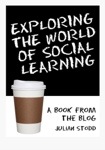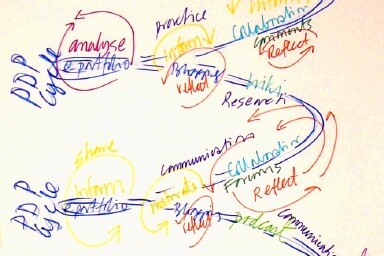Have we dumbed down in the last decade?
I was on H804 BR227 Block 2-A1 on the 19th March 2001. I was in Barbara's Tutor Group.
The block reading was extensive; it had arrived in a large cardboard box, along with CD-roms. Books galore. I've numbered the 33 items from which I need to read x paper or chapters. Have we dumbed down in the last decade?
Is reading, if only on a Kindle, no so valid?
Has quantity of content provided been replaced by the quantity of content we generated between each other? If so, it makes contribution the peer group and module cohort all the more important.
We are meant to browse through these and select one. Skim reading as a ‘good study technique’ of the 1990s at the OU. Is this no longer so? I fancy an Amazon reviewing approach to all required reading. I’d then pick one five star, one three star and one that hadn’t received a rating. It’s about as good as my old technique – alphabetical order. Skim read 33 items then choose one? Never. Read all of them, then choose surely. In business if I had to review products, or interview new candidates would I do the job properly, or just give them a cursory glance? ‘If you find something on ODl course design in the set books, or in H80X Resources, which is not currently listed in the Reading guide, just email me with the details. Ill add it to the list. John (John Pettit).
Interestingly a article we then read from Cisco does something similar to the review suggestions above, not as basic as a start rating but ‘Sounding Off’ in which the first few words of comment and listed from sixteen or so commentators.
I then turn to printed off pages, marked up with a highlighter pen. (I can’t find myself stumbling across such paperwork with such Serendipity in ten years time should I care to reconsider the contents of MAODE 2010-2011. It will be buried in, by then, 10,000 assets in my e-portfolio. As I call it, like looking for a needle in a stack of needles. Something no string of tags can save you from … because every item has a similar set of tags. Where is ‘serendipity’ 2021? Years ago I put an ‘Enter@Random’ button in my blog., I’m yet to think of a more sophisticated way to tap into my mind).
In this article John Chambers CEO of CISCO says
‘The next big killer application for the Internet is going to be education.’
This is too often misquoted outside the realm of corporate training – what he has in mind here is how to keep 4,000 Cisco sales people up to speed and better able to sell, not how to educate classroom based school kids.
Is the next step the Open School?
To home educate? It would make better use of what the Internet offers. I do wonder how or why I’ve ended up nailed first to the locally primary school and then an affordable private school within walking distance. My wife and I are both freelance, who cares where we could be in the world as we do everything online.
Remind me to go to the estate agents. We’re selling up!
Meanwhile, I’m glad to see ‘e-learning’ used here; I was convinced it was a term coined recently. ‘Ultimately, Tom Kelly says, e-learning will be most effective when it no longer feels like learning – when it’s simply a natural part of how people work.’ If you do things in small chunks, she continues, they become just another part of your job. And what I like most of all, ‘E-learning will be successful when it doesn’t have its own name.’
My children wouldn’t call it e-learning
It’s just homework, whether in a text book or using a computer, which may or may not go online. Do we different where our TV feed comes from anymore? It’s just more TV. It is has taken me exactly one week, courtesy of a Kindle, to drop any idea of e-readers, e-books or e-reading … these are books, this is reading – the means of distribution is different, that’s all, it’s as if I have an electronic butler handing me one sheet of the book at a time. Bliss.
I’m still some way off why I’m reading this and writing about, just picking up echoes from the past as I go through it. Kelly had some insights on e-learning (which he defines as Web-based education):
- Small is beautiful
- Blends are powerful
- Measure what matters
- New technologies require new leaders
Was I listening back then?
I think we were too busy trying to reinvent the world.
These four points are understood today as:
Chunking Participation across platforms The business of measuring outcomes. Simply put ‘If technology adoption occurs faster because the sales force is better-trained, we have real business impact that’s measurable.’
And then the punch line
“One real; problem with e-learning is that traditional training people are in charge of it. No wonder it doesn’t work! Can you imagine if the post office was in charge of email?”
Does this apply to libraries?
Think of a book as a parcel, a report as a letter. Do we want it delivered by the Post … or by email? Are librarians best equipped to migrate digitised content to the e-brain?
There is then a paper, I guess the equivalent of a lecture, a piece of content purpose-written for the course. It is good to see Vygotsky, Piaget and Papert in here .. but what of Prensky from ‘The Power of Digital Game based Learning' and this suggestion by Prensky via research done by cognitive psychologists ‘such as Bruer and Tapscott in the late nineties who speculated that the young people’s minds have been literally ‘altered by the effect of a key set of digital formative experiences'. Prensky then, no better than a salesman links a truism with an unproven (and unfounded) suggestion. ‘Tapscott’s research indicated that young people are living, playing, communicating, working in and creating communities very differently than their parents (truism) and that the ‘hard wiring’ of young people’s brains has been effectively altered by digitally based learning experiences in the last decade.’ (unfounded, 'effectively altered' is what alerts me).
Let me see what I can find, where all just a click away from Google
So I buy this to feast on:

I’m going to have to go through these notes.
Courtesy of Kindle I can highlight and take notes.
I find myself rattled by everything Prensky says and how it is presented, from the glowing recommendations, to his extensive biography, to the unqualified, uncited, unresearched 'hear say' that considers itself to be serious study. He mentions the 'popular writer Malcolm Bradbury' but falls into the same trap of conjuring up presumptions that have no foundation in fact. This is less than journalism. It is invention. It may be what he thinks, but no one gets a word in edge ways to say whether he is right or wrong.
As I read I felt as if I was at best listening to an after dinner speech, at worst a stand-up comic
Prensky preaches to the converted, a certain group of secondary and primary school teachers who I can see nodding along to every platitude that Prensky offers.
That's my summary; the report will follow
Book by book, blow by blow.
Seeing Prensky so often quoted in the OU files, in 2001 and still, surprises me.
I feel like the little boy in the crowd pointing out that the King is wearing no clothes.
I may eat my words, I often do
But for now, this is my stance, which I prefer to sitting on the fence.
REFERENCE
Cisco’s Quick Study by Ann Muoio. From FC issue 39, page 286. http://www.fastcompany.com/online/39/quickstudy.html
Prensky M (2001) Digital Game based learning, McGraw Hill.




